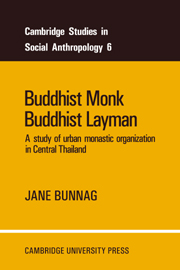Book contents
- Frontmatter
- Contents
- List of tables
- List of illustrations
- Preface
- Map A Thailand
- Introduction: the Thai social system
- 1 ‘The way of the monk’
- 2 The monk and the lay community
- 3 The wat community
- 4 The wat and its social matrix
- 5 The role of the Buddhist layman
- 6 The loosely structured social system: red herring or rara avis?
- Appendixes
- Bibliography
- Index
2 - The monk and the lay community
Published online by Cambridge University Press: 06 January 2010
- Frontmatter
- Contents
- List of tables
- List of illustrations
- Preface
- Map A Thailand
- Introduction: the Thai social system
- 1 ‘The way of the monk’
- 2 The monk and the lay community
- 3 The wat community
- 4 The wat and its social matrix
- 5 The role of the Buddhist layman
- 6 The loosely structured social system: red herring or rara avis?
- Appendixes
- Bibliography
- Index
Summary
Son, wife and father, mother, wealth
The things wealth brings, the ties of kin
Leaving these pleasures one and all
Fare lonely as a rhinoceros.
Verses from the Patimokkha translated by Edward Conze (Conze 1959, p. 81)Having defined very broadly the scope and limits of a Thai monk's activities, it is now necessary to analyze more specifically the concepts and notions entertained by various informants as to how these varied activities should be evaluated, and to discuss the implications of this evaluation for relations between the monk and the layman. As might be expected, the order in which these role-attributes are placed varies according to the mental sophistication and scriptural education of the informant concerned; which latter qualities would in themselves tend to have certain rather loose spatial correlates. One would expect for example that a monk from one of the more academic Bangkok monasteries would have a concept of his role more similar to the Theravada ideal with which he is familiar from his own reading than would a semi-literate monk in a remote rural village, who is besides subject to more pressures from the laity to develop his less orthodox extra-curricular talents, as was mentioned above in the preceding chapter. The average small-town bhikkhu falls somewhere between these two extremes.
- Type
- Chapter
- Information
- Buddhist Monk, Buddhist LaymanA Study of Urban Monastic Organization in Central Thailand, pp. 51 - 85Publisher: Cambridge University PressPrint publication year: 1973



